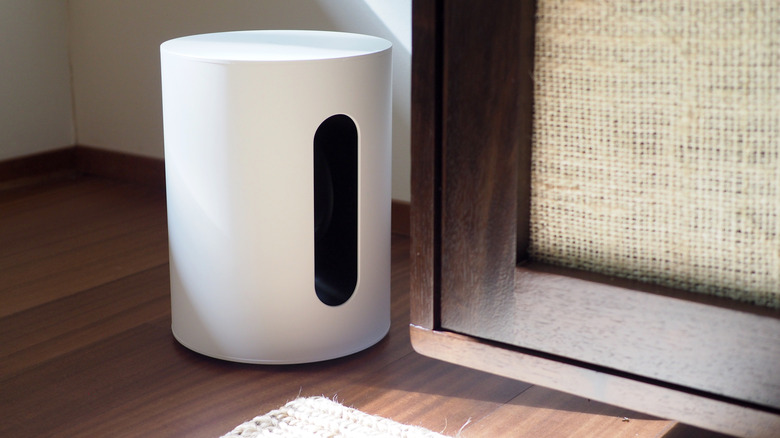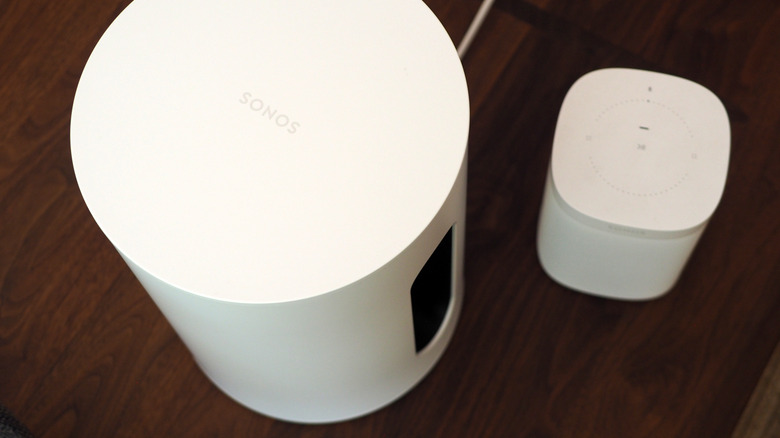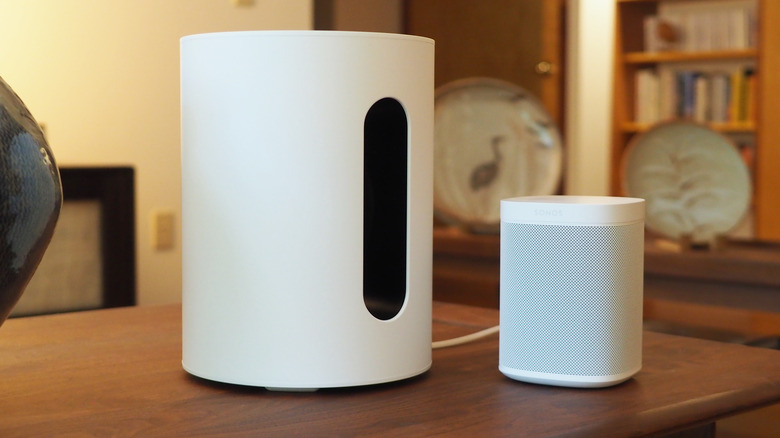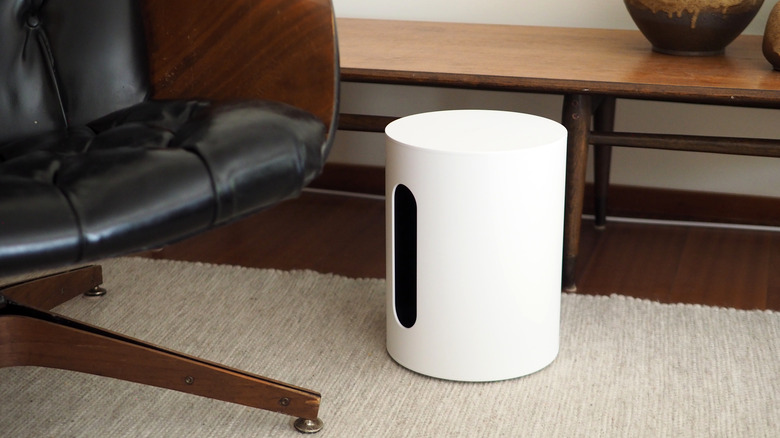Sonos Sub Mini Review: When Smaller Makes More Sense
- More affordable than full-size Sonos Sub
- Very easy setup
- Adds welcome low-end to speakers and soundbars
- Still not a cheap addition
- Doesn't work with Sonos' portable speakers
We may receive a commission on purchases made from links.
For some products, you wonder what took them so long. The Sonos Sub Mini is one such example, a more affordable route to adding extra bass to the company's system, whether you need it for your home theater or your music setup. As we've seen before, the promise is performance and simplicity wrapped up in a design you wouldn't necessarily feel bad about leaving out in the open.
The current Sonos Sub is a burly monster. While Sonos pitches it as an easy way to add more low-end to your audio, that doesn't mean it stints on audio quality. Back when I reviewed it as part of a Sonos Architectural installation — complete with a Sonos Arc soundbar and a pair of in-ceiling speakers driven by a Sonos Amp — the Sub proved more than capable of delivering more bass than was required in my medium-sized room.
In fact, you could argue that its talents were moderately squandered on the space. That can make it a challenge to justify, too, given the price tag. At $749, it's almost as expensive as an Arc itself.
Plug & play, just smaller
For big, serious home theater rooms — or, indeed, music-centric spaces, where two Sonos Five might be paired in stereo with a Sub for the bass — that price tag seems fair. For those who have a small-to-medium-sized media room, though, or who are looking to add low-end to a pair of Sonos One speakers, perhaps, $749 could readily blow the budget.
What Sonos fans have long wanted, then — and what has long been a weird omission for a company that has multiple speakers and soundbars to suit different room sizes and budgets — was a smaller subwoofer. One that doesn't sacrifice the plug-and-play simplicity of its bigger sibling, but which also doesn't break the bank in the process.
That's where the Sonos Sub Mini comes in. It's $429, or $20 less than the Sonos Beam Gen 2 soundbar it's perhaps most likely to be paired with. As with the full-size Sub, installation is a matter of plugging in a mains cord, and after that, it pairs wirelessly with whichever other speakers are in the space. That might be a soundbar for TV and movie use, or regular Sonos speakers for audio.
Designed to leave in plain sight
Most of the time you don't see subwoofers. Because the bass frequencies they supply are non-directional, unlike a traditional speaker, you can tuck them out of the way under a side table or behind the sofa. That almost seems a shame with the Sub Mini, however.
Circular in cross-section, it's just over 9 inches across and 12 inches tall, finished in Sonos' familiar matte white or black polycarbonate plastic. At 14 pounds, it's hefty, though far from the far more weighty Sub, which tips the scales at over 36 pounds. The keyhole slot cut through the center not only accommodates the pair of drivers — more on which in a moment — but also makes for a useful place to pick the Sub Mini up.
In fact, where I wouldn't generally plan on moving the Sub around, the Sub Mini seems a little more amenable to being switched between rooms. It's not, ostensibly, intended for that — it can't be paired with Sonos' mobile speakers, the Roam or Move, in fact — but I did have it set up for home theater use in one room and then take it to another for music with a pair of Sonos One.
Super-simple setup
Making that straightforward is Sonos' app (the Sub Mini is, like the company's other recent launches, only compatible with the Sonos S2 app, not the S1 released so that its older models can still be used). Setup basically involves plugging the Sub Mini in, tapping your phone on top of the wireless tag built into the flat top panel, and then choosing which room it'll be in.
Most people, I suspect, will use wireless networking. The Sub Mini connects to Wi-Fi a/b/g/n 2.4/5GHz networks, but there's also an ethernet port for hardwiring it. If you're using the subwoofer with a soundbar, however, it'll automatically create a direct 5GHz link between the two, so as to avoid any latency or sync issues.
If you remove the Sub pairing, meanwhile, the Sonos app will automatically offer you a list of other rooms and speakers you could connect it to. That way, though not really intended to be moved around, the process of doing so is made pretty simple.
Built for small to medium rooms
Sonos recommends Sub Mini for rooms under 300 square feet in size, albeit with some consideration of the general architecture of the space. If you have particularly high ceilings, for example, or open walls, you still might want to step up to the bigger Sub. Similarly, Sonos suggests Sub Mini will pair most effectively with Beam, Ray, One, One SL, Sonos Amp with smaller bookshelf speakers, and IKEA's Sonos-powered SYMFONISK range.
If you have a Sonos Arc, Five, or Sonos Amp driving larger speakers, meanwhile, or a bigger room generally, you'll probably want to stick with a full-size Sub. That, at least, is the theory, though it really comes down to how you listen.
Sonos' argument for not recommending Sub Mini with, say, Arc is that the soundbar can be just plain too powerful for the smaller subwoofer to keep up with. At higher volume levels, then, that could leave the bass sounding — comparatively — weedy. Of course, if your primary use of Arc is at lower volumes but because you still want the full Dolby Atmos it's capable of, then you may not ever reach the limits of Sub Mini's contribution. Unlike with an existing Sub, you can't pair two Sub Mini together in the same space. If you were considering it, you'll get more performance out of a single Sub, Sonos argues.
Tinkerers need not apply
This is not an audio product for the avid tinkerer. Like other Sonos speakers, there's a little tweaking you can do — here, it's manually adjusting the bass — but that's it. Sonos takes care of setting the bass frequency and crossover levels itself, depending on what speakers you're pairing Sub Mini to. Sonos Trueplay, which uses an iPhone to adjust things like EQ depending on the acoustic conditions of the room, also helps shape Sub Mini's settings.
With Trueplay run, but everything otherwise left at the defaults, everything sounds solid and natural. Sub Mini doesn't stand out — and nor, frankly, would you want it to — but you definitely notice a fuller low-end. The subwoofer has two 6-inch woofers each with a Class-D amplifier, and a 25Hz frequency response.
Overall, it's a really solid foil to the sparkle that Sonos One and Sonos Ray bring. The soundbar, in particular, really benefits from an extra chunk of low-end. While it's good with dialog and delivers in the mid and high end, Sonos' cheapest soundbar can't match the bass that its larger counterparts add in, and while I wouldn't say it sounds weedy, you definitely don't get the full boom and rumble from action movies.
Made for both home theater and music
With a Beam (Gen 2), the pairing seems even more fitting. Again, Sonos' soundbar isn't lacking, per se, but at higher volumes, you definitely come to appreciate the Sub Mini's contributions. If you're in an apartment, I'm not sure your neighbors would appreciate it, but inviting them over for popcorn on a movie night may persuade them.
On the music side, what stands out is how well-rounded the Sub Mini sounds with a pair of Sonos One set up in stereo mode. Again, it's not so much that you specifically notice the subwoofer — or, for that matter, that the Sonos One feels unbalanced on its own. With the three linked, however, there's definitely a welcome kick of bass in dance and rap music, while orchestral tracks gain a fullness to the deeper instruments. The question, of course, is whether all this is actually worth $429. That's midrange in Sonos terms, but still not cheap.
Sonos Sub Mini verdict
If I was putting together a home theater setup, the Sub Mini would still be the last component I'd add to the shopping list. A Ray and a pair of Sonos SL speakers for use as the rear surround channels, for instance, come in at $642, and I think most people would be better off starting there than the $673 Ray and Sub Mini bundle.
The reality is, though, few Sonos owners stop at just one product. And, whether it's a home cinema setup or one for music, the allure of adding extra low-end without splashing out several primary speakers-worth of cash on a full-size Sonos Sub is clear. Bigger spaces, and more serious room configurations, will still want that big daddy subwoofer, but the Sub Mini makes far more sense for the mainstream listener.
As usual, it's the easiness with which Sonos delivers everything that stands out. Being able to quickly add more bass in a couple of minutes (most of that time spent waiting for the subwoofer to configure and, when fresh out of the box, update to the latest software) without messing with settings and such is a nice contrast to a lot of home theater audio systems. While Sonos is definitely not the cheapest platform, the Sub Mini is far more attainable and easily justified than the Sub it'll coexist alongside, and an easy low-end fix that's been long overdue.







